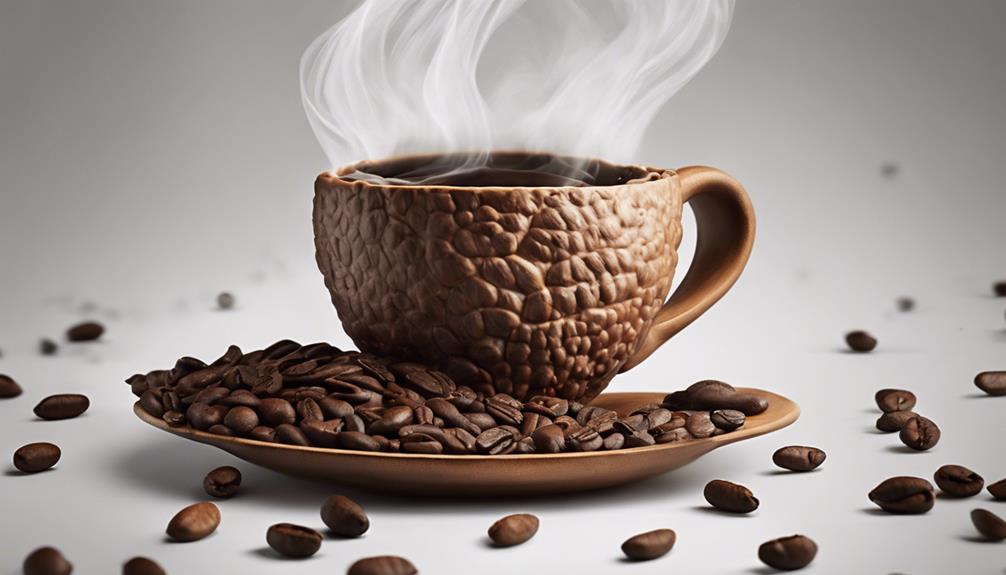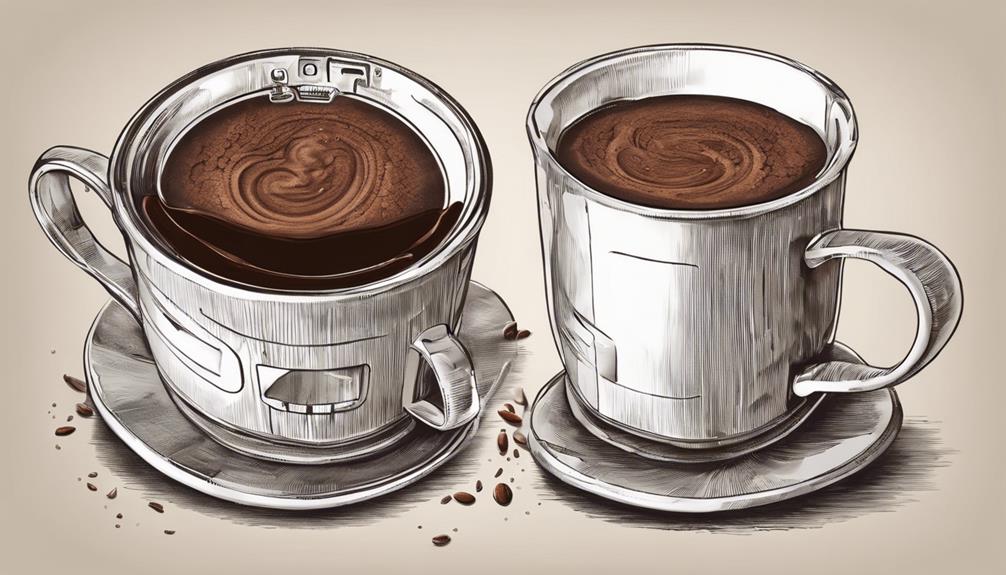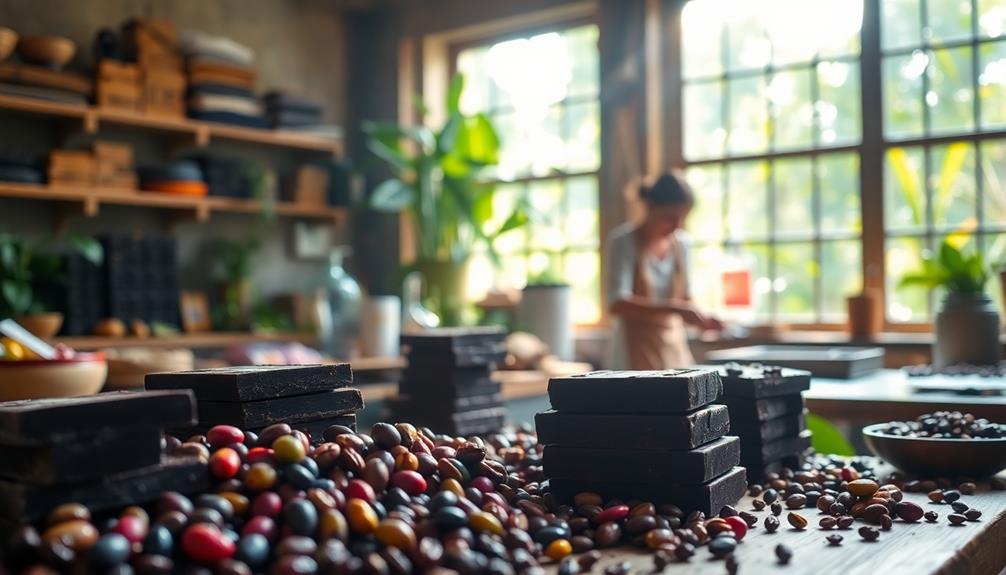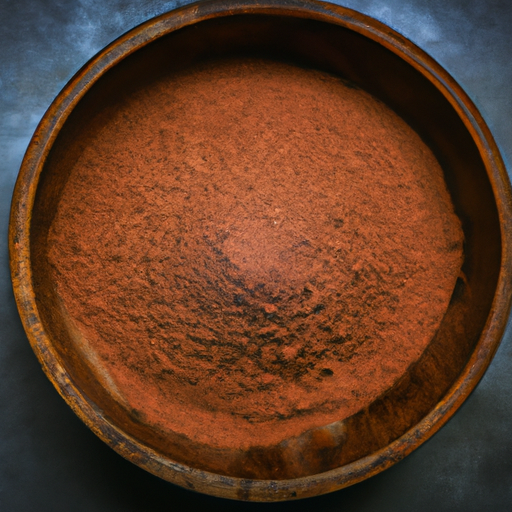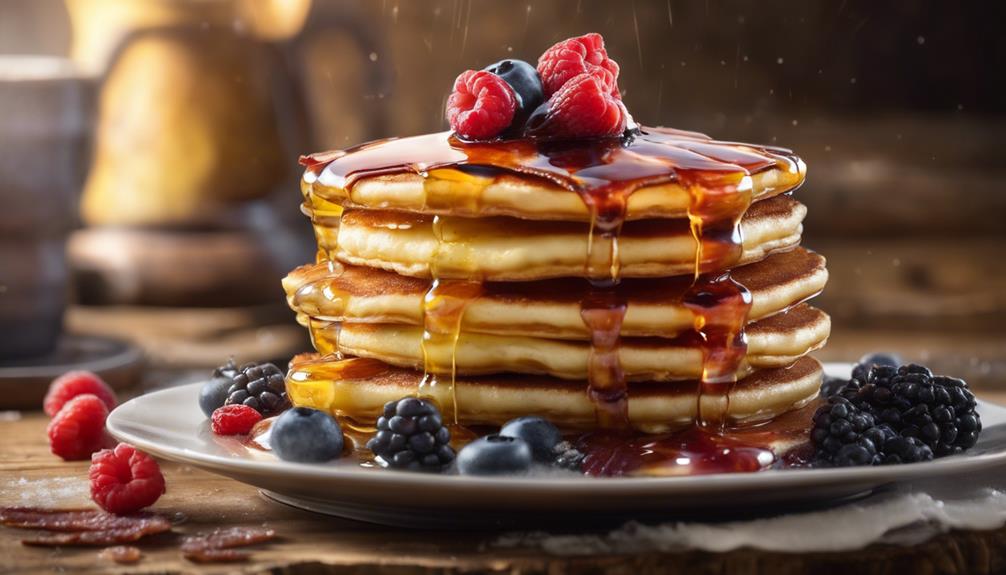When comparing cacao and coffee in terms of caffeine content, it is important to note that coffee contains approximately 95 mg of caffeine per cup, providing a rapid energy boost, whereas cacao offers 12-26 mg per serving with a slower absorption rate. The decision between these beverages depends on individual energy requirements and preferences. Cacao is a good source of antioxidants that promote heart health, whereas coffee contains nutrients such as potassium and niacin. The theobromine found in cacao offers a gentle, sustained energy lift compared to the quick, intense energy spike from caffeine in coffee. Recognizing these distinctions can help in making informed decisions based on energy needs and health advantages.
Key Takeaways
- Coffee has higher caffeine content (95 mg per cup) compared to cacao (12-26 mg per serving).
- Cacao offers a slower absorption rate of caffeine, providing a gentler energy lift.
- Individual energy needs and preferences determine whether to choose cacao or coffee.
- Cacao's theobromine provides sustained energy, while coffee offers quick, intense energy.
- Understanding caffeine differences helps in selecting between cacao and coffee for energy requirements.
Caffeine Content Comparison
When comparing the caffeine content between cacao and coffee, it's apparent that coffee typically contains much higher levels of caffeine per serving. While coffee packs around 95 mg of caffeine in a single cup, cacao only offers a modest 12-26 mg per serving. This significant difference means that if you're looking for a quick energy boost, reaching for a cup of coffee might be more effective due to its higher caffeine content.
Understanding the caffeine content in cacao and coffee is important when deciding which one to choose for that much-needed pick-me-up. The faster absorption rate of caffeine in coffee means that it can provide a quicker energy surge compared to cacao. So, if you need a sudden burst of energy, a cup of coffee might be the way to go. However, if you prefer a milder energy lift or are more sensitive to caffeine, cacao could be a suitable alternative. It's all about knowing what works best for your body and energy needs.
Health Benefits Analysis
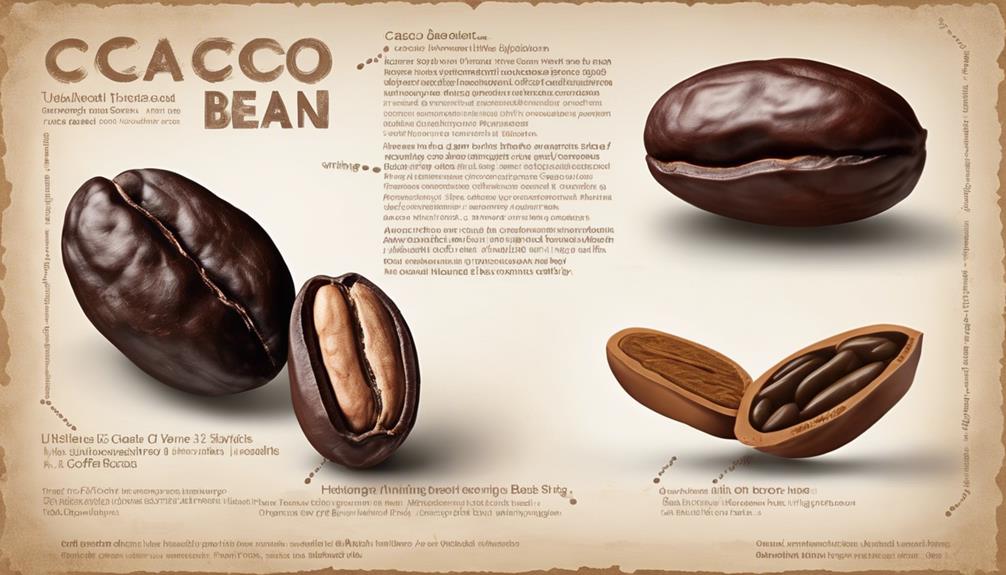
Let's now compare the nutrient content of cacao and coffee to understand their impact on our metabolism.
By analyzing their health benefits, we can see how these two beverages affect our bodies differently.
Understanding these aspects can help us make informed choices about incorporating cacao and coffee into our diets for overall well-being.
Nutrient Content Comparison
Comparing the nutrient content of cacao and coffee reveals distinct health benefits associated with each. Here's a breakdown to help you understand the differences:
- Antioxidants: Cacao is rich in antioxidants, which support heart health and mood enhancement.
- Minerals: Cacao contains minerals like magnesium and iron, while coffee provides nutrients like potassium and niacin.
- Energy: Theobromine in cacao offers a gentle energy lift, while coffee's caffeine content provides a quick energy boost.
- Overall Wellness: Both cacao and coffee offer wellness benefits beyond indulgence, making them valuable additions to a balanced diet.
Understanding these differences can help you make informed choices about which beverage aligns best with your health goals.
Impact on Metabolism
Cacao and coffee both play a significant role in impacting metabolism through their respective stimulant properties. Cacao contains theobromine, which stimulates the central nervous system and enhances blood flow, leading to a boost in metabolism. On the other hand, coffee's caffeine content can also increase metabolism and energy expenditure. Below is a comparison table showcasing the impact of cacao and coffee on metabolism:
| Cacao | Coffee |
|---|---|
| Theobromine in cacao stimulates the central nervous system and improves blood flow, boosting metabolism. | Caffeine in coffee enhances metabolism, aiding in calorie burning and fat oxidation. |
| Provides sustained energy lift without rapid spikes and crashes associated with caffeine. | May temporarily boost metabolic rate, leading to increased energy expenditure. |
Both cacao and coffee can positively influence metabolism, but individual responses may vary based on sensitivity to caffeine and theobromine.
Theobromine Vs. Caffeine
Theobromine and caffeine are two compounds that affect the body in distinct ways.
While caffeine provides a quick, intense energy boost, theobromine offers a more sustained effect without the jittery feeling.
Understanding their differences and effects on the body can help us choose between cacao and coffee for our daily pick-me-up.
Chemical Differences Explained
Exploring the chemical disparities between theobromine and caffeine reveals distinct effects on the body's energy levels. Here's a breakdown to help you understand the differences between these two compounds:
- Theobromine, present in cacao beans, provides a sustained and milder energy boost compared to caffeine.
- Theobromine acts as a vasodilator, widening blood vessels to enhance blood flow throughout the body.
- Coffee contains around 280 mg of caffeine per 250ml serving, while cacao has approximately 43.5 mg per 15g serving.
- Theobromine, named after Theobroma Cacao, offers a gentle pick-me-up, contrasting with the powerful caffeine kick you get from coffee.
Understanding these distinctions can help you choose between cacao and coffee for your daily energy needs.
Effects on Body
Comparing the effects on the body between theobromine and caffeine reveals distinct differences in how they impact energy levels and bodily functions. While caffeine provides a quick and intense energy boost, theobromine in cocoa offers a more sustained and gentle lift without the jitters. Caffeine stimulates the central nervous system, increasing alertness, while theobromine acts as a vasodilator, enhancing blood flow. Here's a comparison table to illustrate the differences:
| Criteria | Theobromine (Cocoa) | Caffeine (Coffee) |
|---|---|---|
| Energy Boost | Sustained and gentle | Quick and intense |
| Impact on CNS | Acts as a vasodilator | Stimulates CNS |
| Caffeine Content | Approximately 43.5mg per 15g | 280mg per 250ml |
Opting for cocoa over coffee can reduce overall caffeine intake while still providing a healthful energy lift.
Health Benefits Compared
Enhancing overall well-being, both cacao and coffee offer distinct health benefits beyond just their caffeine content. When comparing theobromine in dark chocolate to caffeine in coffee, here's what stands out:
- Theobromine in cacao supports heart health and mood enhancement, promoting a sense of well-being.
- Caffeine in coffee enhances cognitive function and physical performance, aiding in focus and alertness.
- Theobromine provides a smooth energy lift without jitters, offering sustained vitality.
- Caffeine offers quick energy but may lead to insomnia with excess consumption, affecting sleep quality.
Understanding these differences can help you choose between the two based on your health goals and lifestyle preferences.
Energy Boost Potential

When it comes to providing an energy boost, cacao and coffee offer distinct levels of caffeine content. Cacao, in the form of chocolate, provides a milder energy lift compared to coffee. A 15g serving of cacao contains approximately 43.5 mg of caffeine, offering a gentle and sustained alertness due to its theobromine content.
On the other hand, coffee delivers a stronger jolt of energy with around 280 mg of caffeine per 250ml serving. The caffeine in coffee acts as a quick stimulant, providing an instant boost of energy. While cacao's theobromine stimulates the central nervous system for prolonged alertness, coffee's caffeine gives a rapid energy surge.
Antioxidants and Minerals Overview
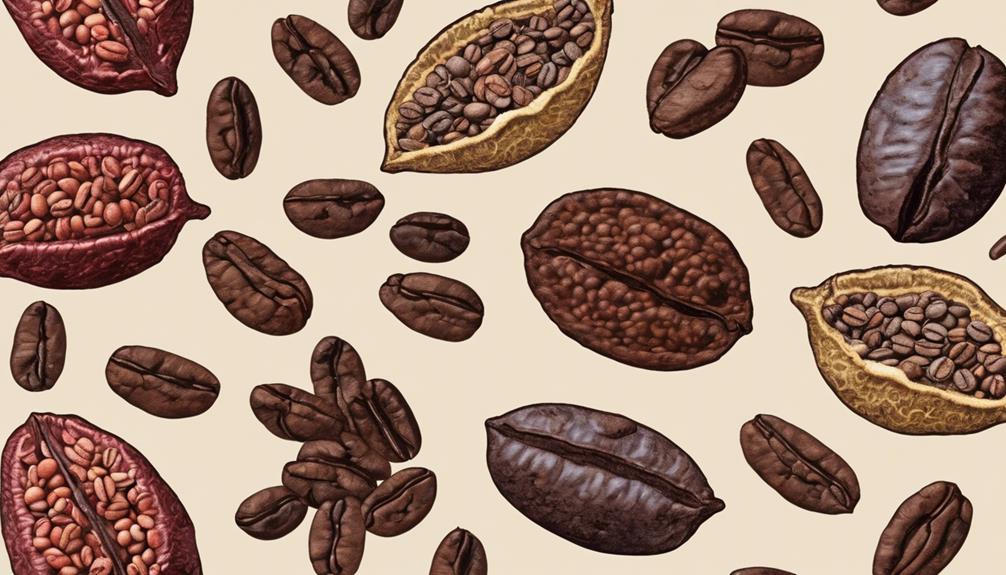
Cacao and coffee both offer a variety of antioxidants and minerals that contribute to overall health and well-being. Here's a breakdown of the key antioxidants and minerals found in these popular beverages:
- Antioxidants in Cacao: Cacao is packed with antioxidants, particularly flavonoids. These compounds are beneficial for heart health and can help reduce inflammation in the body.
- Nutrients in Coffee: Coffee is a good source of essential nutrients like riboflavin, niacin, and potassium. These nutrients play an essential role in maintaining overall health and well-being.
- Minerals in Cacao: Cacao also contains essential minerals such as iron, magnesium, and calcium. These minerals are crucial for various bodily functions, including muscle function and bone health.
- Health Benefits of Coffee: Studies have shown that coffee consumption is linked to a lower risk of type 2 diabetes. This showcases the potential health benefits of incorporating coffee into your diet for its antioxidants and minerals.
Performance and Metabolism Effects

With its ability to provide a sustained energy boost without the typical caffeine jitters, cacao's theobromine offers a unique advantage in enhancing performance and metabolism. Cacao benefits from providing a longer-lasting lift without the sudden crash that can come with coffee consumption. The theobromine in cacao aids in improving blood flow, which can enhance physical performance during activities like workouts or sports. On the other hand, coffee's caffeine is quickly absorbed, offering a rapid energy spike that can be beneficial for short bursts of activity. However, the gentler and longer-lasting energy lift from cacao can be advantageous for sustained efforts over time, providing a more consistent source of energy without the fluctuations associated with coffee. Consider the table below for a quick comparison between cacao and coffee regarding their performance and metabolism effects:
| Aspect | Cacao | Coffee |
|---|---|---|
| Energy Boost | Sustained without jitters | Quick spike |
| Performance | Enhances with improved blood flow | Enhances through rapid absorption |
| Metabolism | Supports longer-lasting energy | Provides rapid boost |
Heart Health Considerations
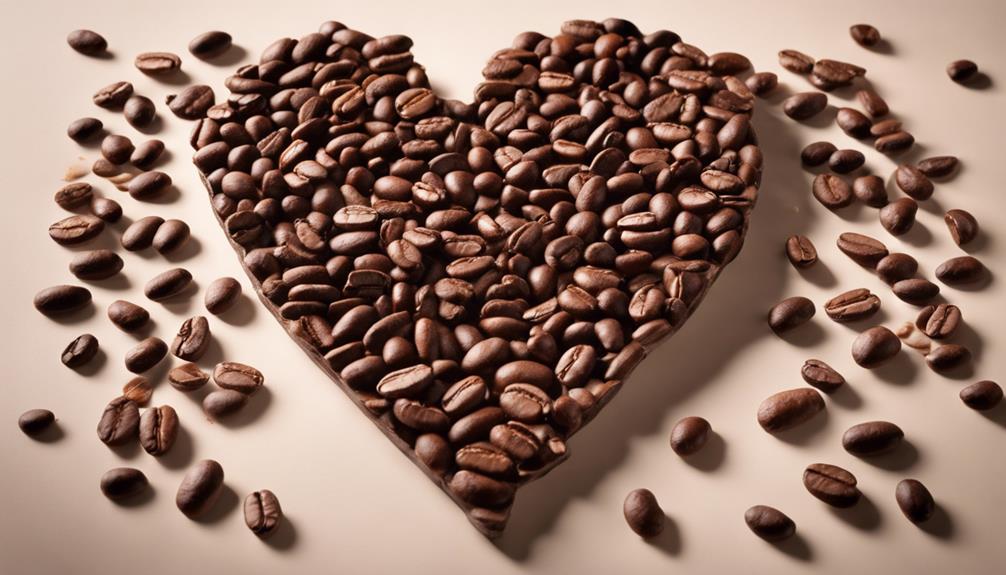
Taking into account the impact on heart health, it's essential to explore the benefits of incorporating both cacao and coffee into a balanced diet. Here are some key points to ponder:
- Theobromine in Cacao: Cacao contains theobromine, which supports heart health by enhancing blood flow and acting as a vasodilator, helping to relax blood vessels and lower blood pressure.
- Reduced Risk: Coffee consumption has been linked to a reduced risk of heart disease and type 2 diabetes, partly due to its protective effects on cardiovascular health.
- Antioxidants: Both cacao and coffee are rich in antioxidants, which play a vital role in protecting the heart from damage caused by harmful free radicals.
- Moderation is Key: Enjoying moderate amounts of cacao and coffee as part of a balanced diet can contribute positively to overall heart health and well-being, providing a tasty way to support a healthy heart.
Mood Enhancement and Stress Relief
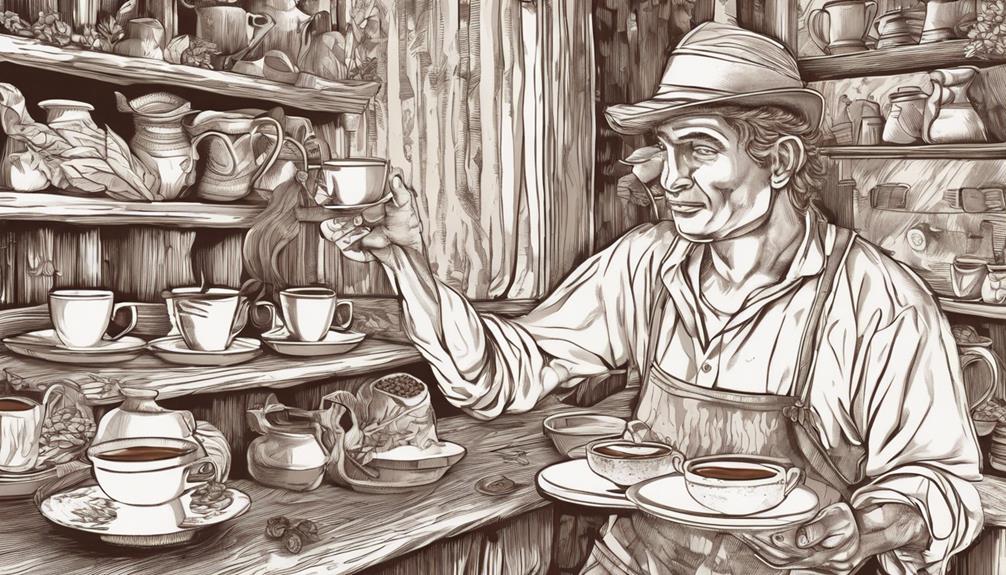
Exploring the impact of cacao and coffee on mood enhancement and stress relief reveals intriguing insights into their potential benefits for mental well-being. Cacao contains theobromine, which is known to promote mood enhancement and stress relief. This compound can help you stay focused and calm, providing a gentle lift in energy levels.
On the other hand, coffee consumption has also been linked to improved mood and reduced stress. The quick boost from coffee can positively impact your mood, offering a different kind of energy lift compared to cacao. Both cacao and coffee present promising opportunities for managing stress levels and enhancing overall well-being.
Whether you prefer the soothing effects of cacao or the energizing jolt from coffee, incorporating these beverages mindfully into your routine can contribute to a more balanced and uplifted mood. So, next time you reach for a cup of cacao or coffee, savor not just the taste but also the potential mood-enhancing benefits they bring.
Anti-inflammatory Properties Evaluation
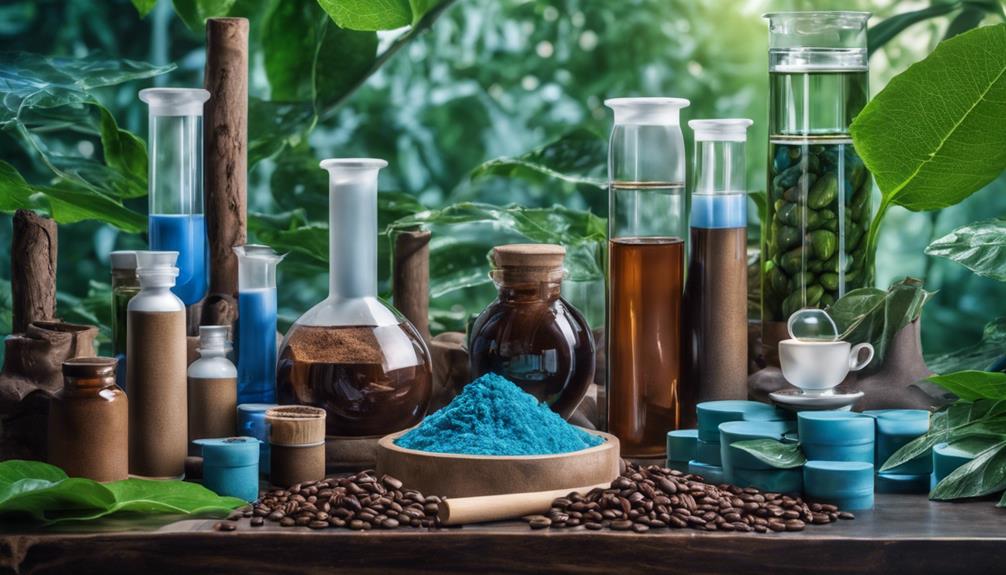
Cacao's flavonoids and coffee's compounds both showcase anti-inflammatory properties, potentially offering health benefits through reducing inflammation in the body.
Here's how the consumption of cacao and coffee can help combat inflammation:
- Flavonoids in Cacao: The flavonoids found in cacao can help reduce inflammation, which may be beneficial for conditions like arthritis and heart disease.
- Compounds in Coffee: Coffee contains compounds that have anti-inflammatory effects, contributing to an overall healthy inflammatory response in the body.
- Antioxidants in Both: Both cacao and coffee are rich in antioxidants, which play a role in combating inflammation-related issues.
- Moderation is Key: Enjoying cacao and coffee in moderation as part of a balanced diet can support an anti-inflammatory diet, potentially benefiting your overall health.
Frequently Asked Questions
Is There More Caffeine in Cacao Than Coffee?
There's actually more caffeine in coffee than cacao. Coffee packs a punch with around 280 mg per serving, while cacao is milder at about 43.5 mg. Opting for cacao over coffee can offer a gentler energy boost.
How Much Caffeine Is in Ceremonial Cacao Vs Coffee?
In ceremonial cacao, there's about 12-26 mg of caffeine per serving, while coffee packs around 95 mg per cup. Choosing cacao offers a gentler caffeine boost compared to coffee, providing balanced energy without the intensity.
How Much Caffeine Is in 70 Percent Cacao?
In a 70 percent cacao dark chocolate bar, there are typically around 25-38 mg of caffeine per 40g serving. It's a delightful way to enjoy a hint of caffeine and savor the benefits of cacao.
Is Cocoa a Stimulant Like Caffeine?
Cocoa, like caffeine, contains theobromine, a milder stimulant. Theobromine in cocoa offers a gentle energy lift without the jitters of caffeine. It acts as a vasodilator, improving blood flow and providing sustained energy.
What are the main differences in caffeine content between cacao and coffee?
When comparing coffee vs cocoa beans differences, it’s important to note that cacao beans contain minimal amounts of caffeine, around 12-20 milligrams per 100 gram serving. In contrast, coffee beans are much higher in caffeine, containing 40-180 milligrams per 100 gram serving.
Conclusion
To sum up, while both cacao and coffee contain caffeine, cacao actually has more theobromine, which can provide a smoother energy boost without the jitters.
Surprisingly, cacao has over 40 times the antioxidants of blueberries, making it a powerful superfood for overall health.
Consider incorporating cacao into your diet for a delicious and nutritious alternative to coffee.

